Yuxiang Chen
TetraJet-v2: Accurate NVFP4 Training for Large Language Models with Oscillation Suppression and Outlier Control
Oct 31, 2025Abstract:Large Language Models (LLMs) training is prohibitively expensive, driving interest in low-precision fully-quantized training (FQT). While novel 4-bit formats like NVFP4 offer substantial efficiency gains, achieving near-lossless training at such low precision remains challenging. We introduce TetraJet-v2, an end-to-end 4-bit FQT method that leverages NVFP4 for activations, weights, and gradients in all linear layers. We identify two critical issues hindering low-precision LLM training: weight oscillation and outliers. To address these, we propose: 1) an unbiased double-block quantization method for NVFP4 linear layers, 2) OsciReset, an algorithm to suppress weight oscillation, and 3) OutControl, an algorithm to retain outlier accuracy. TetraJet-v2 consistently outperforms prior FP4 training methods on pre-training LLMs across varying model sizes up to 370M and data sizes up to 200B tokens, reducing the performance gap to full-precision training by an average of 51.3%.
A Survey of Process Reward Models: From Outcome Signals to Process Supervisions for Large Language Models
Oct 09, 2025Abstract:Although Large Language Models (LLMs) exhibit advanced reasoning ability, conventional alignment remains largely dominated by outcome reward models (ORMs) that judge only final answers. Process Reward Models(PRMs) address this gap by evaluating and guiding reasoning at the step or trajectory level. This survey provides a systematic overview of PRMs through the full loop: how to generate process data, build PRMs, and use PRMs for test-time scaling and reinforcement learning. We summarize applications across math, code, text, multimodal reasoning, robotics, and agents, and review emerging benchmarks. Our goal is to clarify design spaces, reveal open challenges, and guide future research toward fine-grained, robust reasoning alignment.
Oscillation-Reduced MXFP4 Training for Vision Transformers
Feb 28, 2025Abstract:Pre-training Transformers in FP4 precision is becoming a promising approach to gain substantial speedup, but it comes with a considerable loss of accuracy. Microscaling (MX) data format provides a fine-grained per-group quantization method to improve the representation ability of the FP4 format and is supported by the next-generation Blackwell GPU architecture. However, training with MXFP4 data format still results in significant degradation and there is a lack of systematic research on the reason. In this work, we propose a novel training method TetraJet for a more accurate FP4 training. We comprehensively evaluate all of the quantizers involved in the training, and identify the weight oscillation problem in the forward pass as the main source of the degradation in MXFP4 training. Therefore, we introduce two novel methods, EMA Quantizer (Q-EMA) and Adaptive Ramping Optimizer (Q-Ramping), to resolve the oscillation problem. Extensive experiments on Vision Transformers demonstrate that TetraJet consistently outperforms the existing 4-bit training methods, and Q-EMA & Q-Ramping can provide additional enhancement by effectively reducing oscillation. We decreased the accuracy degradation by more than $50\%$ compared to the baseline, and can even achieve competitive performance compared to full precision training. The codes are available at https://github.com/thu-ml/TetraJet-MXFP4Training
Jetfire: Efficient and Accurate Transformer Pretraining with INT8 Data Flow and Per-Block Quantization
Mar 19, 2024Abstract:Pretraining transformers are generally time-consuming. Fully quantized training (FQT) is a promising approach to speed up pretraining. However, most FQT methods adopt a quantize-compute-dequantize procedure, which often leads to suboptimal speedup and significant performance degradation when used in transformers due to the high memory access overheads and low-precision computations. In this work, we propose Jetfire, an efficient and accurate INT8 training method specific to transformers. Our method features an INT8 data flow to optimize memory access and a per-block quantization method to maintain the accuracy of pretrained transformers. Extensive experiments demonstrate that our INT8 FQT method achieves comparable accuracy to the FP16 training baseline and outperforms the existing INT8 training works for transformers. Moreover, for a standard transformer block, our method offers an end-to-end training speedup of 1.42x and a 1.49x memory reduction compared to the FP16 baseline.
Preserving Knowledge Invariance: Rethinking Robustness Evaluation of Open Information Extraction
May 23, 2023Abstract:The robustness to distribution changes ensures that NLP models can be successfully applied in the realistic world, especially for information extraction tasks. However, most prior evaluation benchmarks have been devoted to validating pairwise matching correctness, ignoring the crucial measurement of robustness. In this paper, we present the first benchmark that simulates the evaluation of open information extraction models in the real world, where the syntactic and expressive distributions under the same knowledge meaning may drift variously. We design and annotate a large-scale testbed in which each example is a knowledge-invariant clique that consists of sentences with structured knowledge of the same meaning but with different syntactic and expressive forms. By further elaborating the robustness metric, a model is judged to be robust if its performance is consistently accurate on the overall cliques. We perform experiments on typical models published in the last decade as well as a popular large language model, the results show that the existing successful models exhibit a frustrating degradation, with a maximum drop of 23.43 F1 score. Our resources and code will be publicly available.
Syntactically Robust Training on Partially-Observed Data for Open Information Extraction
Jan 17, 2023



Abstract:Open Information Extraction models have shown promising results with sufficient supervision. However, these models face a fundamental challenge that the syntactic distribution of training data is partially observable in comparison to the real world. In this paper, we propose a syntactically robust training framework that enables models to be trained on a syntactic-abundant distribution based on diverse paraphrase generation. To tackle the intrinsic problem of knowledge deformation of paraphrasing, two algorithms based on semantic similarity matching and syntactic tree walking are used to restore the expressionally transformed knowledge. The training framework can be generally applied to other syntactic partial observable domains. Based on the proposed framework, we build a new evaluation set called CaRB-AutoPara, a syntactically diverse dataset consistent with the real-world setting for validating the robustness of the models. Experiments including a thorough analysis show that the performance of the model degrades with the increase of the difference in syntactic distribution, while our framework gives a robust boundary. The source code is publicly available at https://github.com/qijimrc/RobustOIE.
Are we really making much progress? Revisiting, benchmarking, and refining heterogeneous graph neural networks
Dec 30, 2021

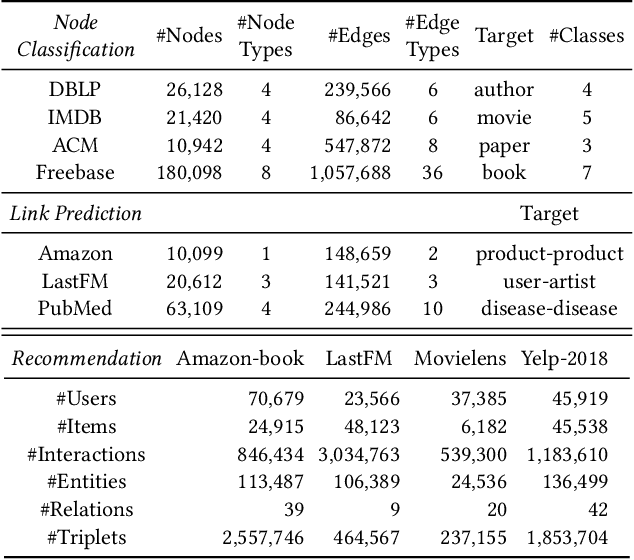
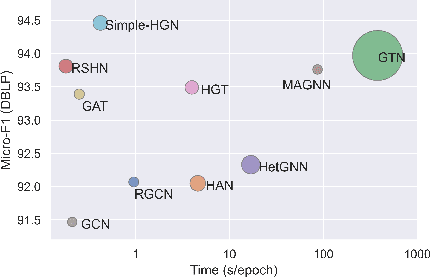
Abstract:Heterogeneous graph neural networks (HGNNs) have been blossoming in recent years, but the unique data processing and evaluation setups used by each work obstruct a full understanding of their advancements. In this work, we present a systematical reproduction of 12 recent HGNNs by using their official codes, datasets, settings, and hyperparameters, revealing surprising findings about the progress of HGNNs. We find that the simple homogeneous GNNs, e.g., GCN and GAT, are largely underestimated due to improper settings. GAT with proper inputs can generally match or outperform all existing HGNNs across various scenarios. To facilitate robust and reproducible HGNN research, we construct the Heterogeneous Graph Benchmark (HGB), consisting of 11 diverse datasets with three tasks. HGB standardizes the process of heterogeneous graph data splits, feature processing, and performance evaluation. Finally, we introduce a simple but very strong baseline Simple-HGN--which significantly outperforms all previous models on HGB--to accelerate the advancement of HGNNs in the future.
Augmentation Pathways Network for Visual Recognition
Jul 26, 2021



Abstract:Data augmentation is practically helpful for visual recognition, especially at the time of data scarcity. However, such success is only limited to quite a few light augmentations (e.g., random crop, flip). Heavy augmentations (e.g., gray, grid shuffle) are either unstable or show adverse effects during training, owing to the big gap between the original and augmented images. This paper introduces a novel network design, noted as Augmentation Pathways (AP), to systematically stabilize training on a much wider range of augmentation policies. Notably, AP tames heavy data augmentations and stably boosts performance without a careful selection among augmentation policies. Unlike traditional single pathway, augmented images are processed in different neural paths. The main pathway handles light augmentations, while other pathways focus on heavy augmentations. By interacting with multiple paths in a dependent manner, the backbone network robustly learns from shared visual patterns among augmentations, and suppresses noisy patterns at the same time. Furthermore, we extend AP to a homogeneous version and a heterogeneous version for high-order scenarios, demonstrating its robustness and flexibility in practical usage. Experimental results on ImageNet benchmarks demonstrate the compatibility and effectiveness on a much wider range of augmentations (e.g., Crop, Gray, Grid Shuffle, RandAugment), while consuming fewer parameters and lower computational costs at inference time. Source code:https://github.com/ap-conv/ap-net.
Real-Time Video Super-Resolution on Smartphones with Deep Learning, Mobile AI 2021 Challenge: Report
May 17, 2021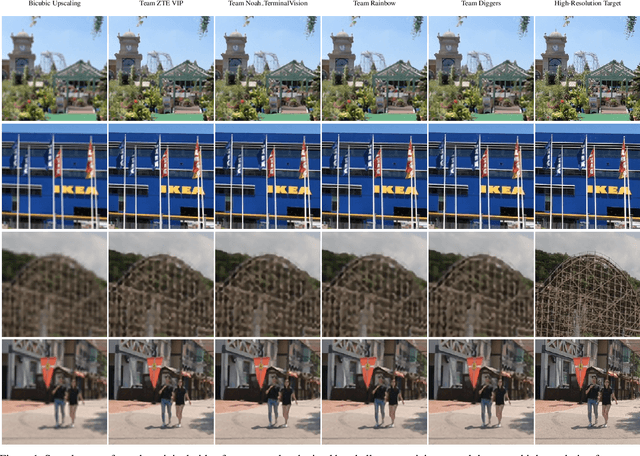

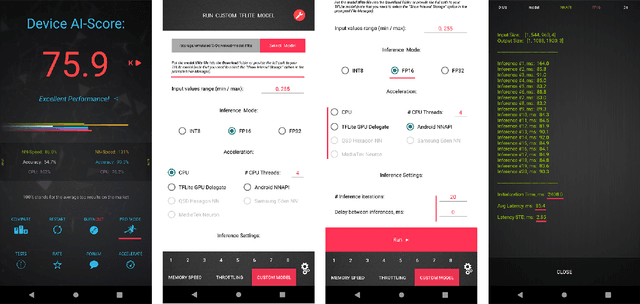
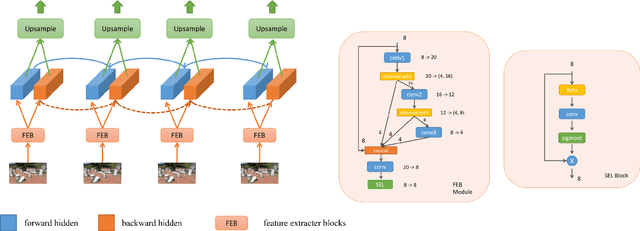
Abstract:Video super-resolution has recently become one of the most important mobile-related problems due to the rise of video communication and streaming services. While many solutions have been proposed for this task, the majority of them are too computationally expensive to run on portable devices with limited hardware resources. To address this problem, we introduce the first Mobile AI challenge, where the target is to develop an end-to-end deep learning-based video super-resolution solutions that can achieve a real-time performance on mobile GPUs. The participants were provided with the REDS dataset and trained their models to do an efficient 4X video upscaling. The runtime of all models was evaluated on the OPPO Find X2 smartphone with the Snapdragon 865 SoC capable of accelerating floating-point networks on its Adreno GPU. The proposed solutions are fully compatible with any mobile GPU and can upscale videos to HD resolution at up to 80 FPS while demonstrating high fidelity results. A detailed description of all models developed in the challenge is provided in this paper.
Products-10K: A Large-scale Product Recognition Dataset
Aug 24, 2020



Abstract:With the rapid development of electronic commerce, the way of shopping has experienced a revolutionary evolution. To fully meet customers' massive and diverse online shopping needs with quick response, the retailing AI system needs to automatically recognize products from images and videos at the stock-keeping unit (SKU) level with high accuracy. However, product recognition is still a challenging task, since many of SKU-level products are fine-grained and visually similar by a rough glimpse. Although there are already some products benchmarks available, these datasets are either too small (limited number of products) or noisy-labeled (lack of human labeling). In this paper, we construct a human-labeled product image dataset named "Products-10K", which contains 10,000 fine-grained SKU-level products frequently bought by online customers in JD.com. Based on our new database, we also introduced several useful tips and tricks for fine-grained product recognition. The products-10K dataset is available via https://products-10k.github.io/.
 Add to Chrome
Add to Chrome Add to Firefox
Add to Firefox Add to Edge
Add to Edge